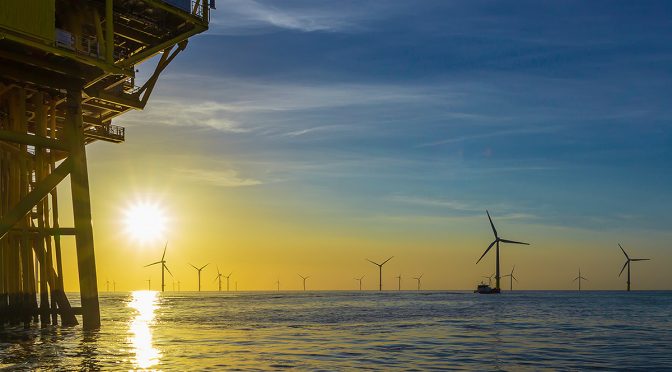Today the European Network of Transmission System Operators for Electricity (ENTSO-E) published EU Offshore Network Development Plans (ONDPs). The ONDPs are the first comprehensive cross-border review of existing offshore grid capacity and future offshore grid requirements at sea basin level. They will help to accelerate the expansion of offshore wind and facilitate the deployment of innovative grid solutions to integrate offshore wind power into Europe’s energy system.
Today WindEurope CEO Giles Dickson and WindEurope Vice-Chair Alfredo Parres attended the launch of the European Offshore Network Development Plans (ONDPs). The ONDPs come on the back of the EU Commission’s EU Grid Action Plan with 14 immediate measures to modernise Europe’s electricity grid and to prepare for the renewables-based electrification of the EU energy system.
The ONDPs translate the EU Offshore Renewable Energy Strategy and the national commitments at the Marienborg and Ostend Summits into offshore transmission equipment needs and related costs.
The plans give visibility to offshore wind developers, investors and the grid equipment supply chain on what offshore grids to expect for each European sea basin by 2030, 2040 and 2050. They’re key to better coordinating the expansion of offshore wind between countries and accelerating its deployment.
496 GW of offshore renewables by 2050
Offshore renewables are set to become the third-most important energy source in the European power system. The EU currently has just under 20 GW of offshore wind. By 2050 it wants at least 300 GW. The ONDPs even see a potential figure of 384 GW of offshore renewables in the EU by 2050 – and 496 GW in Europe as a whole.
Building all these wind farms will require a substantial expansion of offshore grid capacity. To ensure the most efficient grid buildout possible, future grid connections should be designed at sea basin level rather than at national level. ENTSO-E present 5 different ONDPs – one each for the North Seas; the Baltic; the Atlantic Basin; the West Mediterranean; and the East Mediterranean and Black Sea.
“There’s a new urgency around grids in Europe. The ONDPs are a significant step forward. They’ll help people decide how best to build out offshore grids – cost-effective and environmentally friendly. They identify existing grid bottlenecks and how to tackle them. They also inform the evolution of hybrid offshore wind farms, energy islands and other innovative ways of integrating offshore wind power into Europe’s energy system”, says WindEurope CEO Giles Dickson.
Clearing the way for hybrid offshore wind farms
The ONDPs see significant potential for hybrid offshore wind farms – that have connections to two or more countries. Hybrids could become an important part of Europe’s meshed and interconnected offshore grid. According to the ONDPs 14% of all offshore renewables could be connected as hybrids.
Hybrids allow for more efficient energy flows and more coordinated approaches to grid planning. They will strengthen Europe’s energy security, and will help bring electricity costs down for European households and businesses.
The European wind industry is willing to invest in hybrid offshore wind farms if the business model is right. Exactly where and when those hybrids get built will depend on project-by-project investment decisions. But the current regulatory framework does not provide a clear revenue perspective for developers.
Next steps to accelerate offshore wind
To accelerate the expansion of offshore wind:
- the EU must establish the right cross-border cost sharing mechanisms. Under the ongoing EU Electricity Market Design discussions, the EU has proposed Transmission Access Guarantees (“TAG”) which will help de-risk investments in hybrid offshore wind farms. The EU should urgently implement TAGs now.
- transmission system operators (TSOs) must spell out the potential for hybrid connections. TSOs should clearly indicate how much capacity they expect to be connected radial – to one national onshore landing point – and how much capacity they expect to be hybrid – connected to two or more landing points. This is crucial to create long-term market reliability for wind farm developers, OEMs and grid operators.
- the European Commission must give active guidance to Member States. The Commission should take the lead and guide Member States on cross-border cost sharing mechanisms to avoid underinvestment and delays. The Commission must start paying closer attention to whether national grid development aligns with the EU’s energy security and climate targets.
- Member States should be reserving grid capacity and ensure adequate anticipatory investments. This will ensure that their onshore infrastructure is ready to integrate electricity from radial and hybrid offshore wind farms as well as offshore renewable hydrogen production.
“The political support for the growth of offshore wind is extremely strong. Not just in the North Sea, but also in the Baltic, Atlantic, Mediterranean, Black and even the Caspian Sea. But the politics around grid access and grid connections, especially hybrid grid connections, are complicated. It’s essential to resolve the cost-sharing issue as soon as possible. Otherwise the EU risks missing out on investments”, says Giles Dickson.
The ONDPs are a legal requirement under the EU’s revised TEN-E regulation. They will be integrated with national onshore grid development plans. After today’s first launch the ONDPs will be reviewed every two years to bring them in line with technological development and progress on grid development.


